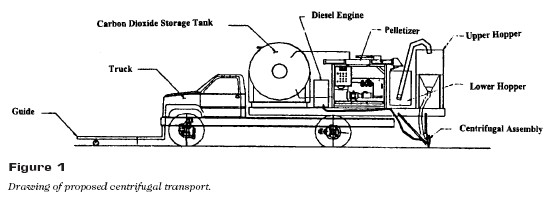This project developed and tested an environment-friendly process for pavement paint removal using pellets. The system uses either air or an electric motor to propel the dry ice pellets. Dry ice pellets are directed at an accelerated rate from a centrifugal system through a gun-like nozzle attached to a single hose (Figure 1) onto the pavement for cleaning paint markings. The centrifugal system propels dry ice pellets at a significantly higher rate than the pneumatic system.
The pneumatic CO2 cleaning system showed excellent results on core samples. However, it was impracticable to use a 2-inch nozzle to remove road marks and stripes on highways. In addition, the exit pattern from the centrifugal system needed to be designed for removing various sizes of road markings and stripes. The test results, however, show that the process is especially suitable for cleaning road markings and stripes. The process can, therefore, be used to restore the brilliance and extend the life of markings and stripes by removing a very fine layer from the top of the existing markings and stripes. In addition, it can be used to remove temporary road markings and stripes. The dry ice consumption was about 150 lbs per hour using the pneumatic system. At this rate, if cleaning could be accomplished in one pass, CO2 cleaning would be cost-effective as compared to burning or grinding markings and stripes.
Tomco is working with the Georgia Department of Transportation to develop a CO2 cleaning system to clean at least at a speed of 5 miles per hour. To do this, the feed mechanism and nozzle needs to be improved. Further field testing is also needed in order to develop a commercially feasible system.This project developed and tested an environment-friendly process for pavement paint removal using CO2 pellets. The system uses either air or an electric motor to propel the dry ice pellets. Dry ice pellets are directed at an accelerated rate from a centrifugal system through a gun-like nozzle attached to a single hose (Figure 1) onto the pavement for cleaning paint markings. The centrifugal system propels dry ice pellets at a significantly higher rate than the pneumatic.

Final Report is not available.